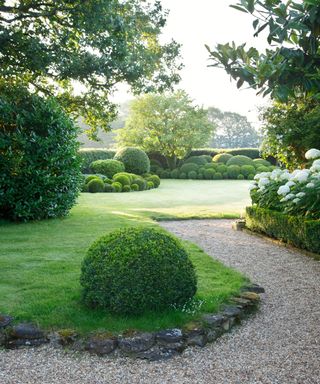Why put sand on your lawn – 4 ways to use this versatile material in your garden
Why put sand on your lawn? These expert-approved tips will promote a healthy lawn in time for summer


Why put sand on your lawn? It’s a question you may have asked yourself if you ever spotted a thin layer of sand on a golf course’s green and wondered about its placement.
While sand is a common tool in the golfing industry, it is less frequently used in domestic settings – but with its host of benefits, this garden idea might just transform your lawn this summer.
From its ability to prevent soil erosion to its supply of crucial nutrients, this accessible material is loved by experts who recommend bringing it into the garden this season. Here’s what you need to know.
Why put sand on your lawn – 4 ways to use this simple product

‘Sand is a natural product that is available everywhere. It’s inexpensive, easy to obtain, and can be used in various ways,’ says Reese L. Robbins, a garden expert from Just Pure Gardening.
‘It is a beneficial product that can improve the appearance of your lawn and shrubs,’ she says. And if you’re growing fruit or looking to improve your vegetable garden ideas, Reese suggests that sand will benefit crop growth too.
1. Using sand for healthier soil
Reese explains that one of the most impactful ways to use sand is to promote healthier soil and slow down erosion. However, she is not alone in her observations.
‘Adding sand to the lawn helps to improve the structure of the topsoil. The perfect soil structure, known as loam, is a combination of sand, clay, and silt particles,’ says RHS-trained gardener Simon Clifford.

2. Using sand to monitor watering
Maintaining the right water levels on your lawn can feel like a challenge, especially in rainier climates. However, you can use sand to control waterlogging for a healthier patch around the year.
‘Many lawns are laid onto a predominantly clay soil which is prone to waterlogging in the winter leading to excess moss build-up. Introducing sand improves the drainage and provides a healthier soil to encourage growth and, ultimately, a healthier-looking lawn,’ Simon adds.
3. Providing nutrients
If you’re looking for a natural way to enrich your lawn, garden expert Daniel Akins from The Yardable suggests using sand. If you use sand as a top-dressing, it will encourage ‘critical nutrients’ to go deeper into the soil and consequently support healthy growth.
So, if you’re looking for ways to improve your wildlife garden ideas, then this sustainable material could be the simple solution you require.

4. Fills in unwanted gaps
According to Daniel, you can also use sand to ‘fill in bare spots caused by other reasons such as animal footprints.’ which may otherwise use an unattractive scar on top-dressed areas. However, the expert warns that this will not work if there has been a lot of rain.
And Reese shares another warning that you should bear in mind when experimenting with sand on your lawn.’Too much of anything will have drawbacks. It is essential to remember that you should not use too much sand as it will suffocate the lawn,’ she says.
Will you put sand on your lawn? If you use this material in moderation, your garden may thank you.
Sign up to the Homes & Gardens newsletter
Decor Ideas. Project Inspiration. Expert Advice. Delivered to your inbox.

Megan is the Head of Celebrity Style News at Homes & Gardens. She first joined Future Plc as a News Writer across their interiors titles, including Livingetc and Real Homes, before becoming H&G's News Editor in April 2022. She now leads the Celebrity/ News team. Before joining Future, Megan worked as a News Explainer at The Telegraph, following her MA in International Journalism at the University of Leeds. During her BA in English Literature and Creative Writing, she gained writing experience in the US while studying in New York. Megan also focused on travel writing during her time living in Paris, where she produced content for a French travel site. She currently lives in London with her antique typewriter and an expansive collection of houseplants.
-
 5 items I never throw out – and how I reuse them around my home
5 items I never throw out – and how I reuse them around my homeI share the five things I never throw out when I can help it, and reveal the five ways I reuse them around my house to help limit the impact on the environment
By Chiana Dickson Published
-
 Michael Douglas and Catherine Zeta-Jones' simple kitchen cabinet color is a masterclass in balance and contrast
Michael Douglas and Catherine Zeta-Jones' simple kitchen cabinet color is a masterclass in balance and contrastA classic cabinet color shines in the actors' kitchen. The actors space proves why this traditional look is always in style
By Sophie Edwards Published